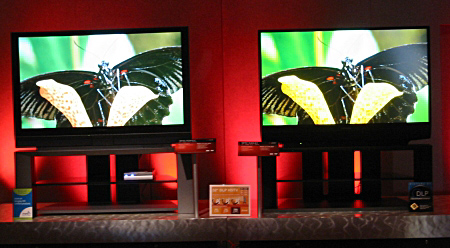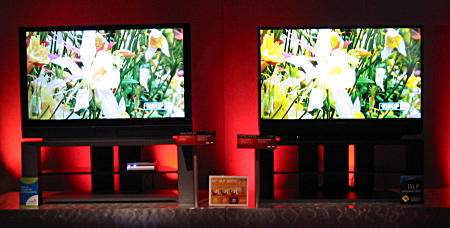Mits Line Show 2006
There were of course the potpourri of new models, most of which were 1080p, but it what was in those models that was notable. It seems like nearly everything that we complained about in the Feb 2006 face off has been addressed.
First and foremost, all the 1080p TVs now correctly de-interlace 1080p, along with the ability for all of them to accept 1080p (24, 30 and 60) over the HDMI inputs. Most models also will accept a computer over DVI.
They also mentioned something about the new flat-panel LCDs being designed, engineered, and built in the old US of A. Remember the "Made in the USA" stickers? How weird would it be to see one on an LCD?
There were two new technologies that are really interesting. The first is a six-segment color wheel. That's nothing new you say? Well how about each segment being a different color? Instead of six segments of the three primary colors of red, green, and blue creating all the colors, there are three smaller segments of the secondaries (cyan, yellow, and magenta). They're smaller because each can still be created using a combination of the primaries (i.e. red and green make yellow), but now for an extra kick actual yellow (or cyan or magenta) can be used. Audio/News Editor Mark Fleishmann was also at the event, and he got special aside by Mits' product guru Marty Zanfino. In a side-by-side with the same material, Mark later told me the difference with the new six-segment color-wheel vs. the old was "not at all subtle." Here are two pictures he took. A caveat, of course we don't know how each TV was set up, we'll have to wait for a review sample to be the final judge. Even so, it shows quite a possibility. The 6-color 6-segment is on the right.


I wish I had gotten a better look. I was, however, distracted by shiny lasers.
Lasers! That's what Mits is betting on for the future of RPTVs. While other companies are working on LED lights for their RPTVs, Mits is going strait for the future with full on laser beams. They, amazingly, had a working prototype. With production more than a year away (they're aiming for a Holiday 2007 release), I won't judge the picture quality on the prototype. Ok, yes I will. It wasn't great, but then again with a year or more development time, I'm sure it will change drastically by the time we see it in stores. The promise of the technology is very impressive. In the long term they say that the lasers will be cheaper than UHP (the bulbs in current RPTVs), as the lasers will last the life of the TV. There will be three lasers (R,G,B), which means no color wheel (though it will still be sequential color, so there may be some rainbows, probably less than what's out there now). The lasers won't be scanning (like Sony's seemingly defunct grating light valve). I'll be diving deeper into this in my August Gearworks in the magazine after hopefully visiting the Mits factory and playing with it first hand.
Any questions?













































